Giong Temple in Soc Son, a sacred site nestled amidst majestic mountains, is not only a place preserving the heroic historical traces of the nation but also an attractive cultural and spiritual tourist destination for visitors from all directions. This ancient temple is associated with the legend of Saint Giong, one of Vietnam’s “four immortals,” a hero who defended Van Lang from the An invaders. Visiting Giong Temple, tourists can admire the unique architectural beauty, immerse themselves in the peaceful space, and have the opportunity to learn about profound cultural and historical values, especially the Giong Festival, a UNESCO-recognized intangible cultural heritage.
Exploring Giong Temple in Soc Son
Giong Temple is located on Soc Mountain, Phu Linh commune, Soc Son district, Hanoi, about 40km from the city center. The Giong Temple relic complex is a colorful historical and cultural picture, including many ancient and sacred architectural works, each with its own story and meaning. Exploring Giong Temple will take visitors back in time, returning to the roots of the nation and deeply feeling the precious traditional values.
Getting to Giong Temple
To reach Giong Temple, visitors can choose from many different means of transportation, depending on their preferences and starting point:
Bus: This is an economical and convenient public transport option for tourists. From the center of Hanoi, you can take bus route 15 (from Long Bien transit point) or bus route 64 (from My Dinh bus station) to Soc Son. Note that these bus routes usually stop in the Pho Ni area or nearby, from here you can take a motorbike taxi or taxi for about 3km to enter the Giong Temple relic area.
Motorbike or private car: For tourists who love freedom and proactivity, motorbikes or private cars are ideal choices. You can travel along two main routes:
- Route 1 (via Nhat Tan Bridge): Follow the direction of Nhat Tan Bridge, do not turn onto National Highway 5 extension, go straight until you meet National Highway 18 (Phu Lo) then turn right. Go a short distance on National Highway 18, then turn left onto National Highway 3. Continue for a while and you will see signs to the Soc Temple relic complex on the left.
- Route 2 (via Thang Long Bridge): Follow the direction of Thang Long Bridge towards Noi Bai Airport. At the intersection with National Highway 18, follow National Highway 18 around behind Noi Bai Airport, follow road 131. When you meet National Highway 3, turn left and go a short distance to Giong Temple.
Taxi or ride-hailing services: If you want to travel quickly and comfortably, taxis or ride-hailing applications like Grab and Gojek are also suitable options. However, the cost will be higher than buses or motorbikes.
Discovering the Giong Temple Relic Complex
The Giong Temple relic complex includes many unique architectural works, imbued with historical and cultural imprints. Each destination contains its own stories and values, waiting for visitors to explore:
Den Trinh (Lower Temple): As soon as you step through the gate of the relic area, Den Trinh will appear before your eyes. This is where the mountain god, the god who governs Soc Mountain, is worshiped. The highlight of Den Trinh is the statue of the mountain god cast entirely in bronze, weighing 7 tons, with a majestic and solemn appearance. The space around Den Trinh is adorned with ancient banyan trees and a green lake, creating a peaceful and ancient scene.

Chua Dai Bi (Dai Bi Pagoda): Continuing past Den Trinh, you will reach Dai Bi Pagoda, an ancient pagoda with architecture imbued with the colors of time. Dai Bi Pagoda attracts visitors with its gilded horizontal lacquered boards and parallel sentences, bearing bold traditional cultural features. The pagoda space is quiet, hidden under the shade of green trees, creating a feeling of relaxation and peace.
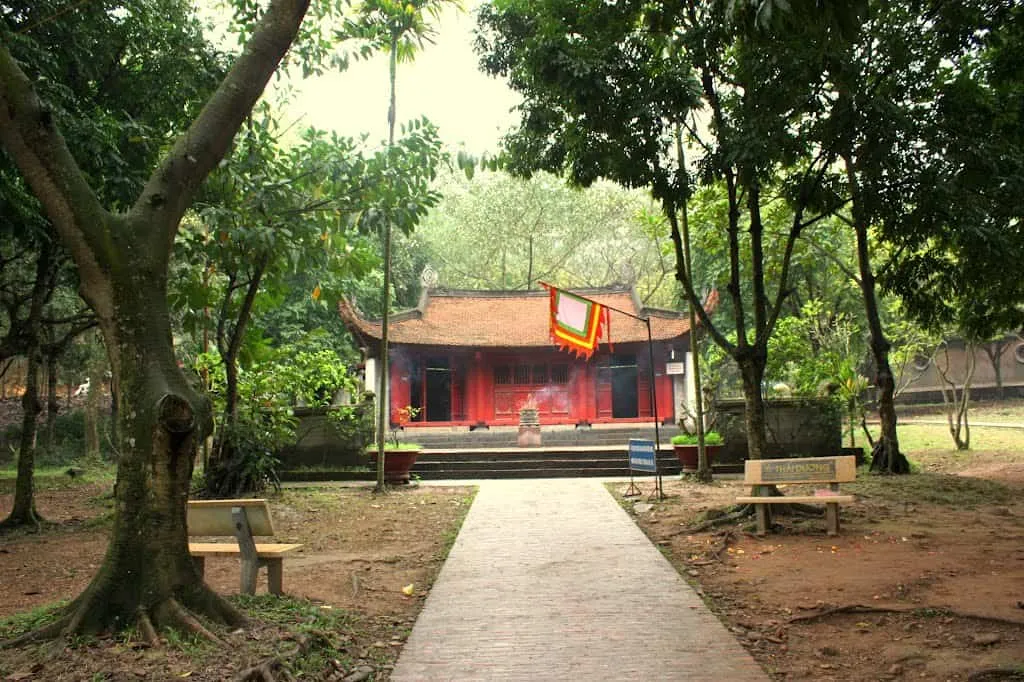
Den Mau (Mother Temple): Opposite Dai Bi Pagoda is Den Mau, where the mother of Saint Giong, who gave birth to and raised the national hero, is worshiped. In Den Mau, visitors can worship the statue of the Holy Mother and learn about the important role of the mother in the legend of Saint Giong. The well outside the temple is also called the Mother’s Well, carrying sacred meaning and associated with the story of Saint Giong’s mother.
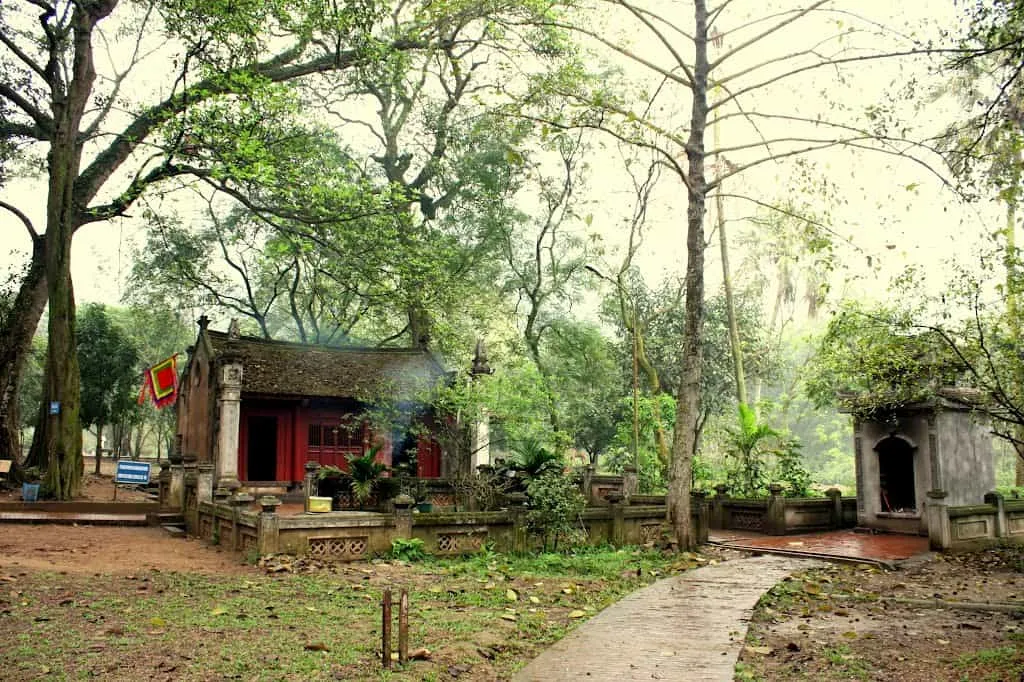
Den Thuong (Upper Temple): Continuing the journey uphill, you will reach Den Thuong, the main temple and the most important highlight in the Giong Temple relic complex. Den Thuong is where Saint Giong, the hero who defeated the An invaders, is worshiped. The architecture of Den Thuong is imbued with traditional style with the Dai Bai house and the Hau Cung. The Dai Bai house is elaborately decorated with parallel sentences, parasols, cranes… The Hau Cung is where the statue of Saint Giong made of agarwood is placed, showing the respect and admiration of the people for the national hero.
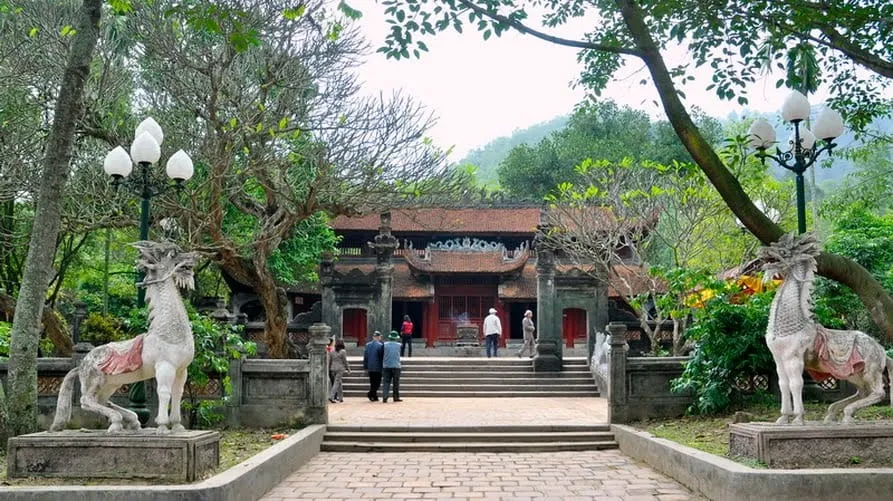
Nha Bia (Stele House): On the way up to Den Thuong, you will encounter Nha Bia, a unique architectural work built entirely of slate. Nha Bia is where ancient stone steles are kept, recording the history of the formation and development of Giong Temple over hundreds of years. These stone steles are valuable documents, helping visitors better understand the historical and cultural values of the relic.
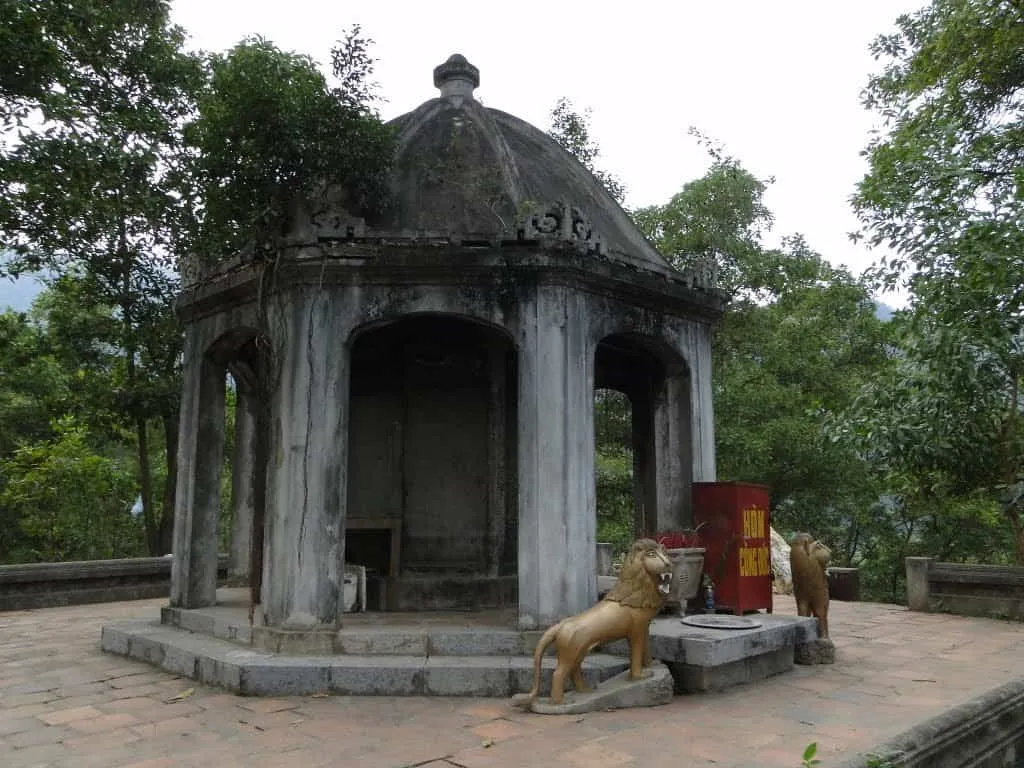
Statue of Saint Giong: The most prominent point and also the symbol of the Giong Temple relic area is the statue of Saint Giong on the top of Da Chong mountain. The statue is cast in pure copper, 11.07m high and weighing 85 tons, depicting the majestic image of Saint Giong, ready to fight to protect the country. The statue was inaugurated in 2010, on the occasion of the 1000th anniversary of Thang Long – Hanoi. Visitors can climb to the top of the mountain along stone steps or take an electric car to admire the statue and see the panoramic view of Soc Son from above.
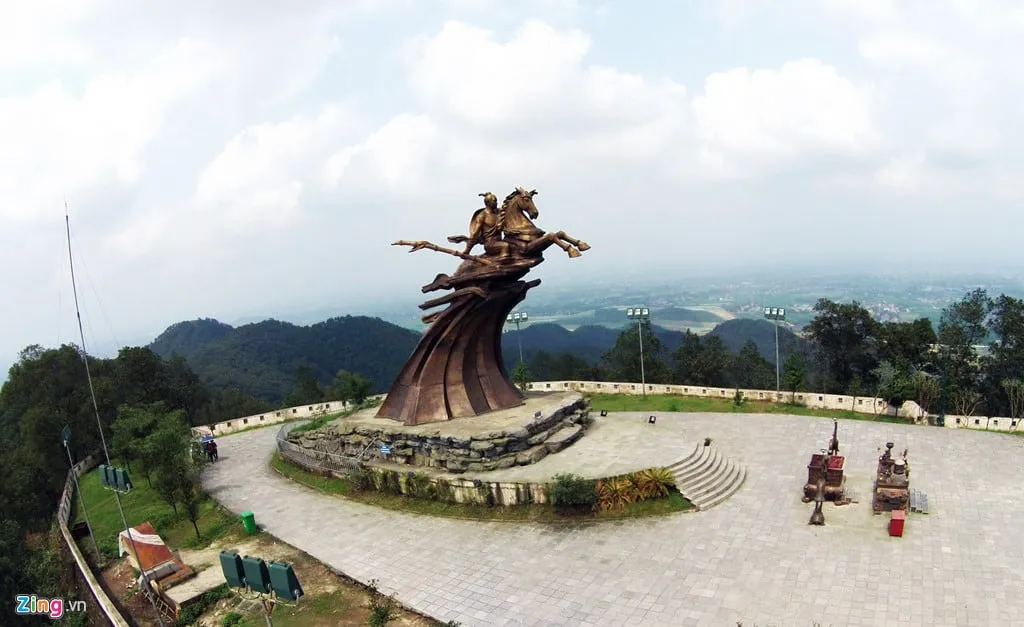
Chua Non Nuoc (Non Nuoc Pagoda): From the statue of Saint Giong, you can visit Non Nuoc Pagoda, a pagoda located halfway up the mountain at an altitude of 110m. Non Nuoc Pagoda is where the bronze statue of Buddha Tathagata, over 8m high and weighing 30 tons, is placed. The pagoda space is peaceful and tranquil, an ideal place for visitors to find silence and peace in their souls.
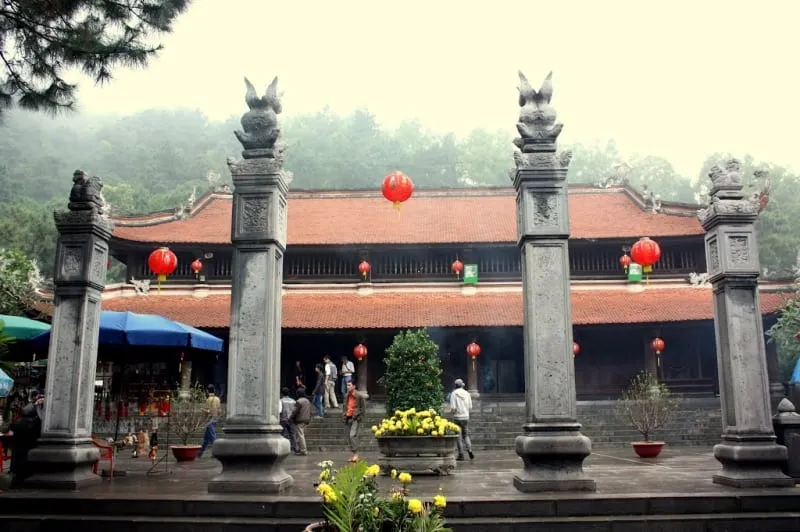

Giong Festival – Intangible Cultural Heritage
The Giong Festival at Soc Temple is one of the largest and most unique traditional festivals in Vietnam. The festival is held annually at Giong Temple in Soc Son to commemorate the merits of Saint Giong. This is not only an occasion for local people to express their gratitude to the national hero but also an opportunity for visitors from all over to discover the unique traditional cultural beauty of Vietnam.
The Giong Festival takes place on the 6th day of the first lunar month every year, with many unique rituals and cultural activities. Visitors will be immersed in the bustling festival atmosphere with traditional rituals such as processions, ceremonies, and folk games such as rice cooking contests, tug of war, wrestling, and Quan Ho singing. In particular, the Giong Festival also recreates the heroic battles of Saint Giong through unique art performances, bringing visitors unforgettable experiences.
In 2010, the Giong Festival was recognized by UNESCO as a “Representative Intangible Cultural Heritage of Humanity”, affirming the great cultural value and lasting vitality of the festival in the spiritual life of Vietnamese people.

Travel Tips for Giong Temple
To have a complete and meaningful trip to Giong Temple, visitors should note some of the following experiences:
- Ideal time to visit: The ideal time to visit Giong Temple is in spring (especially during the Giong Festival in the first lunar month) or autumn. The weather at this time is cool and pleasant, suitable for sightseeing and exploration.
- Dress code: As a spiritual site, visitors should choose polite and discreet clothing when coming to Giong Temple.
- Other notes:
- You should bring comfortable shoes for easy movement and mountain climbing.
- Prepare drinking water and snacks if you intend to climb to the statue of Saint Giong and Non Nuoc Pagoda.
- Maintain general hygiene, do not litter indiscriminately in the relic area.
- If traveling during the festival, you should arrive early to avoid crowds and be able to fully participate in festival activities.
- Hotels near Giong Temple: In the Soc Son area, there are many hotels and guesthouses with different price ranges, meeting the accommodation needs of tourists. You can refer to and book rooms in advance to ensure you have satisfactory accommodation. In addition, you can also choose hotels in the central Hanoi area and travel to Giong Temple during the day.
- Local cuisine: After visiting Giong Temple, visitors can enjoy Soc Son specialties such as Soc Son hill chicken, wild vegetables, and rustic dishes at restaurants and eateries around the area.
Conclusion
Giong Temple in Soc Son is not only an important historical and cultural relic but also an attractive spiritual tourist destination. With its ancient beauty, peaceful space, and profound cultural and historical values, Giong Temple promises to bring visitors memorable and meaningful experiences on their journey to discover Vietnam. Come to Giong Temple to feel and explore the wonderful things this place offers, to learn more about Vietnamese history, culture, and people.